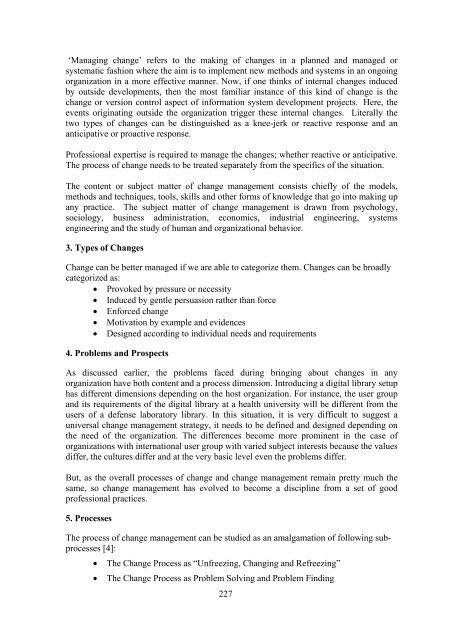7 - Indira Gandhi Centre for Atomic Research
7 - Indira Gandhi Centre for Atomic Research
7 - Indira Gandhi Centre for Atomic Research
Create successful ePaper yourself
Turn your PDF publications into a flip-book with our unique Google optimized e-Paper software.
‘Managing change’ refers to the making of changes in a planned and managed or<br />
systematic fashion where the aim is to implement new methods and systems in an ongoing<br />
organization in a more effective manner. Now, if one thinks of internal changes induced<br />
by outside developments, then the most familiar instance of this kind of change is the<br />
change or version control aspect of in<strong>for</strong>mation system development projects. Here, the<br />
events originating outside the organization trigger these internal changes. Literally the<br />
two types of changes can be distinguished as a knee-jerk or reactive response and an<br />
anticipative or proactive response.<br />
Professional expertise is required to manage the changes; whether reactive or anticipative.<br />
The process of change needs to be treated separately from the specifics of the situation.<br />
The content or subject matter of change management consists chiefly of the models,<br />
methods and techniques, tools, skills and other <strong>for</strong>ms of knowledge that go into making up<br />
any practice. The subject matter of change management is drawn from psychology,<br />
sociology, business administration, economics, industrial engineering, systems<br />
engineering and the study of human and organizational behavior.<br />
3. Types of Changes<br />
Change can be better managed if we are able to categorize them. Changes can be broadly<br />
categorized as:<br />
• Provoked by pressure or necessity<br />
• Induced by gentle persuasion rather than <strong>for</strong>ce<br />
• En<strong>for</strong>ced change<br />
• Motivation by example and evidences<br />
• Designed according to individual needs and requirements<br />
4. Problems and Prospects<br />
As discussed earlier, the problems faced during bringing about changes in any<br />
organization have both content and a process dimension. Introducing a digital library setup<br />
has different dimensions depending on the host organization. For instance, the user group<br />
and its requirements of the digital library at a health university will be different from the<br />
users of a defense laboratory library. In this situation, it is very difficult to suggest a<br />
universal change management strategy, it needs to be defined and designed depending on<br />
the need of the organization. The differences become more prominent in the case of<br />
organizations with international user group with varied subject interests because the values<br />
differ, the cultures differ and at the very basic level even the problems differ.<br />
But, as the overall processes of change and change management remain pretty much the<br />
same, so change management has evolved to become a discipline from a set of good<br />
professional practices.<br />
5. Processes<br />
The process of change management can be studied as an amalgamation of following subprocesses<br />
[4]:<br />
• The Change Process as “Unfreezing, Changing and Refreezing”<br />
• The Change Process as Problem Solving and Problem Finding<br />
227
















